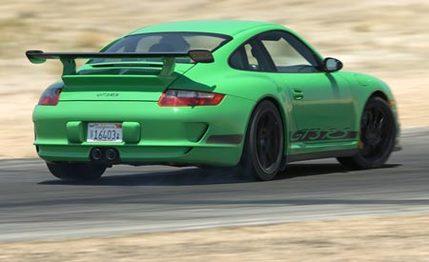 Road Test
Road Test
Unless you have plans to go racing, the purchase of a highly developed sports car constructed primarily to satisfy motorsports homologation regulations is not a purely logical process. The things that make cars fast on the track require certain compromises on the road. There are noise and vibration levels, for example, along with ride quality and control effort.
But in the case of the Porsche 911 GT3 RS, emotion and logic come together to make an unassailable case. The RS (German for rennsport, "racing sport") is a distillation of all the things that have made the 911 a much-sought-after sports car through the ages, and that two-letter appellation evokes all the pride and nostalgia of Porsche racing cars of the early '70s. The RS graphic on the car's side is in the same typeface as the one found on 2.7-liter RS 911s from 1973, and that's no coincidence.
Like that car, the RS was developed with a view to going racing. (It differs from standard GT3s in having wider rear bodywork like that used on the Carrera 4.) Also like the early RSs, this model is available in optional high-visibility tree-frog-green paint, as well as what Porsche calls special Orange.
Those '73 cars are collected avidly by Porschephiles and command high prices. This GT3 RS already has buyers lining up around the block, despite a base price of about 124 grand—assuming you could get one at that figure, which is unlikely. But even at a price fortified by a stiff dealer markup, the RS is a surefire proposition. A production run of a few hundred means the cars will remain as rare as they are technologically extraordinary, guaranteeing a healthy residual value.
Moreover, the high percentage of RSs that will be campaigned in competitive environments ensures that there will be a degree of attrition in the ranks. That means even fewer cars and a better resale value. Obviously, not all of the RS's performance is on the investment side. Its fundamental attractions lie in its ability to put 415 horsepower to the road in a way that makes that quoted output sound like an understatement, and in the sound the engine makes at its 8400-rpm redline, where the 3.6-liter flat-six wails a song reminiscent of a zillion laps at Le Mans, Spa, the Nürburgring, and Daytona.
What's more, the car does a passably good job of rolling around suburbia, given that its 3.7-inches-off-the-deck rubber front air dam soon sports a short, black fringe from fraying at dips and driveways too abrupt to accommodate the car's generous overhang. But the choice of material reflects Porsche's understanding that this will happen, and the rubber is easily replaced.
Then there's the tire noise. If you live in a part of the country with bumpy, broken pavement, expect to hear the playback in Dolby surround sound as you wheel the RS around town. The Michelin Pilot Sport Cup hoops transmit bump thump and rough textures into the car at a fairly high volume, making any concern about the Porsche's engine noise completely groundless. After all, the RS has to meet federal exhaust sound levels during a drive-by test, hopefully conducted on a smooth piece of pavement.
What better reason, then, can there be to attack the fresh pavement of Angeles Crest Highway above La Cañada Flintridge, north of Los Angeles? On this newly extruded asphalt cushion, the RS's wide Michelins go suddenly quiet, allowing the engine to communicate with the driver in a properly intimate fashion. Legal the engine may be, inaudible it is not. You can hear every nuance this marvelous aluminum six-pack has in its repertoire, from the heavily overlaid whine at low speeds that makes it sound like an old fan-cooled unit, to a resonant growl in the midrange, to the manic brassy wail near the redline. The big check buys you front-row seats in the Porsche rennsport symphony, and you'll undoubtedly enjoy every note.